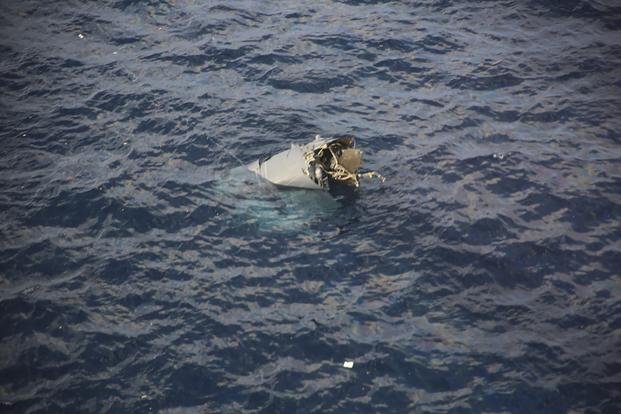Search-and-rescue operations are underway for the crew of an Air Force Osprey that crashed off the coast of a Japanese island Wednesday.
A statement from Air Force Special Operations Command said the CV-22B Osprey, assigned to the 353rd Special Operations Wing, was on a training mission off the shore of Yakushima Island with eight airmen aboard.
"Emergency personnel are on scene conducting search-and-rescue operations," Air Force Special Operations Command said Wednesday morning. "The cause of the mishap is currently unknown."
Read Next: 'Broken and Alone': Father Pens Scathing Letter to Top Brass After Losing Airman Son to Suicide
The Associated Press in Tokyo reported that a crew member who was recovered from the ocean had been pronounced dead, but U.S. officials did not immediately confirm that information Wednesday. Military.com has a policy to withhold the names of those who die while serving until their families have been notified, but the publication was unable to confirm the AP’s reporting of a fatality ahead of publication.
The Japanese Ministry of Defense posted on X that it is assisting in recovery and rescue efforts.
Wednesday's crash marks the latest in a string of deadly Osprey accidents for the Air Force and Marine Corps as the military grapples with a long-standing mechanical issue on the aircraft.
A Marine Corps Osprey crashed in Australia in August, killing three Marines. Another Marine Corps Osprey went down last year in Southern California, claiming the lives of five Marines. Investigation findings released in July showed the cause of that crash was a hard clutch engagement, or HCE, a mechanical issue that has plagued the military for more than a decade.
Despite those problems, Air Force and Pentagon officials told Military.com in recent months that they remain confident in the aircraft.
Lt. Gen. Tony Bauernfeind, the head of Air Force Special Operations Command, told Military.com in September that the command is following mitigation steps issued over the last year to combat HCE incidents.
"We're very confident in the mitigation steps that we've done," Bauernfeind said. "With respect to the CV-22 at large, it is answering a long-held requirement ... that no other capability can answer in the special operations community as we go forward."
Pentagon spokeswoman Sabrina Singh told reporters at a press briefing in late August that "we do certainty have confidence in the Osprey."
The HCE mechanical issue can cause the shredding of components needed to power the Osprey's propellers and to keep the aircraft flying in the event of a single-engine failure.
The issue became public only after the Air Force abruptly grounded its Osprey fleet in August 2022 over a cluster of such incidents. Yet the Marine Corps, which operates the lion's share of the military's Osprey fleet, said the very next day that it didn't need to ground its aircraft.
Officials who spoke with reporters at the time stressed that the issue largely occurs "within seconds after takeoff" and that "in every incident, the aircraft landed safely."
Months later, though, Military.com exclusively reported on a 2017 clutch incident with an Air Force Osprey that happened mid-flight and forced the aircraft to perform an emergency landing with a single engine.
In June 2022, a Marine Corps Osprey -- call sign Swift 11 -- crashed in southern California, claiming the lives of five Marines. In March, the Marine Corps investigation found that they were the first deaths stemming from the HCE problem.
In February, the military announced it would replace the aircraft's input quills -- part of the drivetrain -- as a mitigation measure to stop the HCE issue from happening, but officials wouldn't say how often they would need to be replaced or how many Ospreys would be temporarily out of service as a result.
When the Swift 11 investigation was released, it was learned that the quills were being replaced every 800 flight hours. However, that investigation also revealed that the Marine Corps does not know the definitive cause of the HCE issue. Documents reviewed by Military.com say that the entire "in-reporting" Osprey fleet has now been retrofitted with new input quills.
Despite not understanding what causes HCEs, the Marine Corps says that replacing the quills is a near-perfect, 99% fix. However, the widow of a Marine killed in the Swift 11 incident, as well as aviation experts, told Military.com they were skeptical of this claim.
The Marine Corps and Air Force officially started flying the Osprey in 2007 and 2009, respectively. The Navy got its first operational aircraft more recently, in 2021, according to fact sheets from the services.
Fast-forward to the release of fiscal 2024 budget documents for all the services earlier this year, and something becomes clear: The military is done buying the aircraft.
The latest budget documents, released in March by the Navy, say that the military services ultimately want 464 aircraft -- 360 for the Marines, 48 for the Navy, and 56 for U.S. Special Operations Command and the Air Force.
-- Konstantin Toropin contributed to this report.
-- Thomas Novelly can be reached at thomas.novelly@military.com. Follow him on X @TomNovelly.
Related: Air Force Says It Remains Confident in Osprey Aircraft Despite Recent Deadly Mishaps












